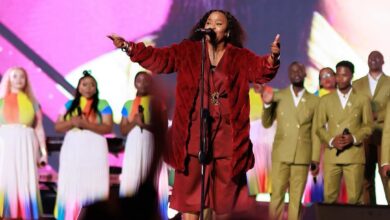Garikai Musabaeka: Visual Art as a Medium for Social Commentary

Garikai Musabaeka, a dedicated visual art teacher, has earned significant attention for his ability to translate pressing social issues into evocative paintings that resonate far beyond Zimbabwe’s borders. His works, known for their thematic depth and powerful storytelling, shed light on challenges affecting communities globally.
One of Musabaeka’s most impactful pieces is Human Trafficking, a mixed-media painting that has stirred awareness and dialogue about the perils of human exploitation. The piece underscores the harsh realities faced by those who fall prey to traffickers and serves as a cautionary tale for individuals considering migration without thorough preparation. According to Musabaeka, Human Trafficking was meant to expose the hidden perpetrators behind these crimes, compelling authorities to act and the public to remain vigilant.
“Art is a mirror reflecting the state of society,” Musabaeka stated. He believes that artists and journalists have a shared responsibility to present accurate narratives that inform and challenge public perceptions.
Another notable work, The Bank Heist, created in 2017, continues to resonate due to its striking portrayal of corruption. Painted on a 60 by 40 canvas, this piece anticipated the economic troubles now manifesting in Zimbabwe’s financial systems. “The relevance of this piece today speaks volumes about art’s ability to predict and parallel real-world situations,” Musabaeka noted.
While his socially conscious work often depicts serious themes, Musabaeka’s artistry also captures moments of cultural celebration. In African Dancers, he employs vibrant colors to express joy, hope, and resilience. The use of bright, distorted forms not only epitomizes African art but also emphasizes the evolving roles of women in modern society.
Musabaeka’s impact is not confined to the galleries where his work is showcased; it extends to educational settings where he encourages students to embrace art as a medium of expression. “When I first created Human Trafficking and The Bank Heist during my college years, they sparked debates that lasted for weeks. It showed me that art can generate substantial dialogue and even influence institutional culture,” he reflected.
However, Musabaeka points out that the visual arts in Zimbabwe face significant challenges, including limited funding and lack of support from stakeholders. Despite these hurdles, he advocates for more comprehensive arts funding, starting from school programs to nurture a culture of appreciation and consumption among Zimbabweans.
The Mutare Art Gallery’s recent closure underscores the difficult environment artists navigate. Musabaeka is vocal about the need for increased investment and community engagement to sustain Zimbabwe’s rich artistic heritage. “We must encourage local art consumption and support to create a thriving ecosystem,” he said. He draws a comparison to the music industry, which has benefited from initiatives such as 100% local content policies.
Musabaeka’s outlook is hopeful but pragmatic. He recognizes that overcoming these challenges requires persistent effort and the involvement of “boundary-pushing” artists and educators. He continues to inspire his students to champion their cultural identity through art and sees the fostering of local appreciation as a foundation for broader success.
“Without the local community’s buy-in, building a sustainable art movement is nearly impossible,” Musabaeka explained. “The future of Zimbabwean art lies in our ability to tell authentic stories, invest in our youth, and embrace the art that encapsulates our identity.”
His works, from Human Trafficking to African Dancers, continue to serve as testaments to the power of visual art to inform, challenge, and inspire change. Through his dedication, Musabaeka emphasizes that art is not just for admiration but is an essential tool for social commentary and transformation.




